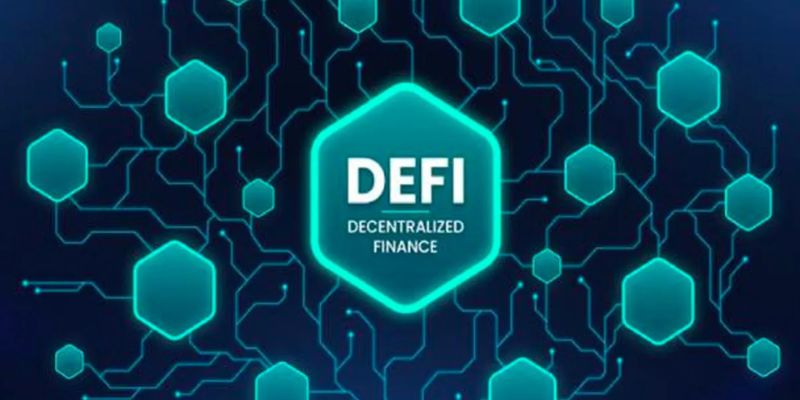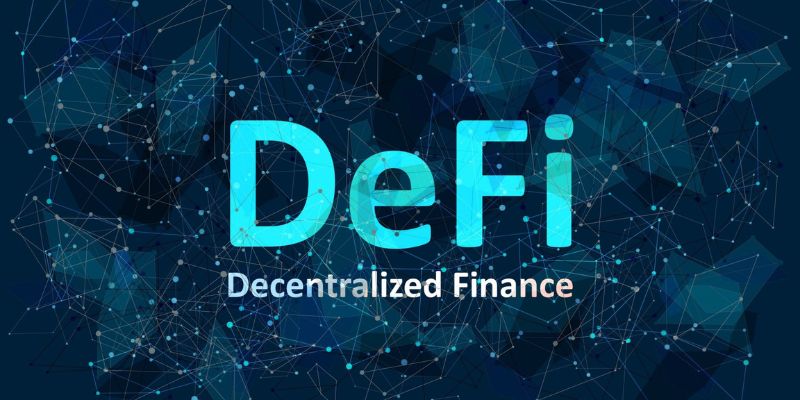What is decentralized finance (DeFi)? Imagine a world where you control your money without a bank in the middle. That’s DeFi. It’s finance built on tech that lets you save, borrow, and grow your cash on your own terms. We’ll dive into how it flips the script on the money game. Think no more long lines, no more hidden fees, just pure, open money moves. Welcome to an exciting journey where we unveil DeFi — the key that unlocks a bold new future of finance. From the nitty-gritty of smart contracts to the big picture of global money shifts, we’re tearing down the old and bringing in the next wave of money matters. Strap in, say goodbye to the old bank tales, and hello to a world where you call the shots. 🚀
Exploring the Foundations of DeFi: From Concepts to Applications
Grasping the Core Principles and Advantages of DeFi
Imagine a world where you control your money. You can lend, borrow, or save without a bank. That’s the heart of DeFi. DeFi stands for decentralized finance. It’s a new way that lets people handle money with just the internet and software. No need for banks or credit cards. It runs on blockchain, that’s a kind of digital ledger.
DeFi is your money playground. You can quickly send cash to friends, get a loan, or even earn interest. And the best part? It works 24/7 – no breaks, no holidays. DeFi helps make finance fair. It cuts out the middleman. That means no hidden fees. You always see what you’re paying for. It gives you power over your cash.
In traditional banking, banks call the shots. They decide how much interest you earn and pay. But in DeFi, it’s up to you. You choose how to grow your money. You can join a pool, where many people put their money to work. Or you can farm yields, which is a bit like getting rewards for playing a game. The rules are clear, and you’re in charge.
How Blockchain and Smart Contracts Power the DeFi Ecosystem
Blockchain is like a super-safe diary that everyone can see but no one can change. It stores every deal you make. With this tech, people trust the system, not a bank or company. And that’s big. Now add smart contracts. They’re like tiny robots that live in the blockchain. They follow rules you set to automate things. When there’s a deal, they get to work, making sure everyone sticks to the plan.
Here’s how they power DeFi. Say you want to lend money. The smart contract holds the borrower’s promise to pay back. It’s like a handshake that never breaks. And if they don’t pay, the contract knows and acts on it. No need to call or email anyone. It’s all in the code.
Smart contracts also help when trading on decentralized exchanges, known as DEXs. There’s no need for a cashier or a trading floor. Just you, your computer, and a world of deals. These contracts can also whip up savings accounts and insurance without the paperwork.
Now, DeFi’s not all sunny days. There are risks, like scams or tech hiccups. But as a DeFi guide, I tell folks to start small and learn as they go. It’s important to be careful, but don’t let fear keep you from this exciting space.
With cryptocurrencies and stablecoins, DeFi’s making money moves right now. It’s shaping a world where everyone gets a shot at building their wealth. So, let’s dive into DeFi and unlock the future of money together.
DeFi and Traditional Finance: A Comparative Analysis
Key Differences Between DeFi and Traditional Banking Systems
Money matters. But the way we handle it is changing fast. You may have heard about DeFi. The big deal here is understanding DeFi is like having a bank in your computer, with you in charge. No need for a brick building or people in suits! Let’s chat about DeFi vs. traditional banking. DeFi lets anybody with internet join the game. You use cryptocurrency, not paper money. Smart contracts function like auto-pilots for your money moves. They follow rules without bias or breaks. Think about the last time you sent money to a friend. A bank had to nod yes. In DeFi, a smart contract does that with no delay. There’s more trust because you see all steps on the blockchain.
Now, about risks. DeFi is still new, and that means bumps on the road. But don’t worry, we got safety nets. Risks come from tech hiccups or bad guys finding loopholes. Always check where you put your money. Look for proven DeFi protocols and stick to them. Remember, safer doesn’t mean risk-free. So, be smart and keep your eyes open.
Addressing DeFi’s Risks and Security Measures
You get the no-middleman deal with DeFi, but it does carry risks. The big one is security. Yes, it’s online, and yes, that means hackers can try to sneak in. But here’s the scoop: DeFi is getting tougher on security. There are non-custodial wallets, locked tight with your secret password. Losing it means saying bye-bye to your money, so be careful.
Think of DeFi like a vault. You alone know the combo. It’s power and responsibility in your pocket. Always backup your keys and use different layers of security. Some folks worry about DeFi scams and frauds. It’s simple – don’t trust everything you see. Wise up by reading and asking questions. No one will look after your dough better than you.
In DeFi, you play both the player and the coach roles. You set the rules for your money, making DeFi benefits shine. But, like any game, know the field. Learn about smart contracts and how they’re different from asking a bank clerk for help. Blockchain in finance is the new frontier, and you’re a pioneer. Gear up, partner, and let’s explore this world together.
To wrap it up, getting the hang of DeFi takes some doing. But once you do, you’ll see the perks. Your money moves fast, you call the shots, and no more waiting in lines or filling out piles of paper. It’s a big step towards the future of money, and you can be a part of it. So, dive in, stay safe, and let’s change the game.
The Mechanics of DeFi: Understanding Its Functional Components
The Role of Liquidity Pools, Yield Farming, and Protocols
Imagine DeFi as a huge playground. In this space, the games you play are all about swapping, saving, and making your money grow. It’s all possible thanks to some key parts that make everything work.
First up, let’s talk about liquidity pools. Think of them as giant pots of money that let people swap different kinds of cash. What makes them cool is they’re not run by one person or bank – anyone can put their money in, and it’s run by rules written in code, which are called smart contracts. These pools are the fuel that keeps the DeFi engine running. They let you trade without needing to match your trade with someone else’s directly.
Yielding farming is another exciting bit. It’s like planting seeds in a garden, but the seeds are your coins, and the garden is a DeFi project. People put their crypto into a pool and help make the market work smoothly. In return, they earn more crypto. It’s a way to make your money work for you, without a bank in the middle.
Now, you can’t talk about DeFi without mentioning the protocols. These are the rules that tell all the parts of DeFi how to work together. They’re really just smart contracts that handle the money in the pools and the rewards you get from yield farming.
Navigating Lending, Borrowing, and Savings in the DeFi Space
Moving on to lending and borrowing in DeFi, it’s a bit like getting a loan or opening a savings account, but it’s all done directly between people, with no banks in sight. You can lend out your coins, and in return, you get interest – kind of like what a bank pays, but often more.
Borrowing in DeFi is pretty handy too. You can take out a loan without filling out lots of forms or waiting for a banker to say yes. Just make sure you have something to back up your loan, like other crypto, and you’re good to go.
Last but not least, DeFi savings accounts. These are places where you can keep your crypto and watch it grow. They can be safer than just holding onto your coins and hoping they go up in price, and you can make a steady return.
But here’s a serious tip: all these cool features come with risks. There’s no 911 for DeFi if something goes wrong. It’s all about being smart and knowing what you’re getting into. Security is super important, so you’ve got to keep an eye out for scams and make sure the code running the show is solid.
In a nutshell, DeFi is full of chances to make your money grow without using a traditional bank. It’s all run on blockchain, with smart contracts making the magic happen. From joining in a liquidity pool, to growing your savings, it’s one exciting world to explore. Just remember, with great power comes great responsibility – so stay safe out there!
The Future of DeFi: Potential Impact and Growth Trajectories
The Importance of Financial Inclusion and Interoperability in DeFi
You know how some folks have no bank? DeFi is changing that. It’s about fair money access for all. This means financial inclusion. With DeFi, if you have internet, you can join in. No need for a bank! Plus, with blockchain in finance, your info stays safe and you call the shots.
Now, let’s chat about interoperability within DeFi. Imagine different money tools that all work together like best pals. That’s what we’re aiming for. But why does it matter? Because it makes everything smooth and easy. You can move money or use services without a headache. Better yet, it levels the playing field in finance.
Emerging Trends: DAOs, Staking, and the Rise of Flash Loans
Next up, let’s peep some fresh trends! First up, DAOs or decentralized autonomous organizations. Imagine a club where everyone’s vote counts on big money moves. That’s a DAO. No bosses here, just us and the rules we agree on. Pretty cool, right?
Got cryptocurrency lying around? Put it to work with staking in DeFi. It’s like planting a money seed and watching it grow. You help keep the system going, and you get more coins. It’s passive income, made simple.
Now for the wildcard – flash loans in DeFi. These are super quick loans that you get and pay back at lightning speed. No collateral needed. Use them right, and you can make tidy profits on quick trades.
So, what’s the lowdown here? DeFi is not just a buzzword; it’s got real muscle to change how we deal with dollars and cents. We’re talking big steps towards everyone having a fair shot at financial growth. From everyday people to big-time investors, there’s a spot for everyone at the DeFi table. The path we’re on could lead us to a future where money is more open, more connected, and a heck of a lot smarter.
We’ve walked through DeFi’s basics and its huge leap from old-school banking. We’ve seen how blockchain and smart contracts make DeFi tick. We compared DeFi to traditional finance, noting how they differ and addressing security concerns in DeFi. We also dived into DeFi’s workings like liquidity pools and the ins and outs of lending and saving.
As we look ahead, DeFi’s promise for financial inclusion and its growing trends like DAOs can’t be ignored. It’s an exciting time in finance, and we’re just at the start. Remember to stay sharp on security as you dip your toes into these new financial waters. And here’s one last tip: keep learning, because DeFi’s not slowing down. This wave of finance is just getting started, and you won’t want to miss out!
Q&A :
What is Decentralized Finance (DeFi)?
Decentralized Finance, or DeFi, refers to an umbrella term for a variety of financial applications in cryptocurrency or blockchain geared toward disrupting financial intermediaries. DeFi draws inspiration from blockchain, the technology behind the digital currency bitcoin, which allows several entities to hold a copy of a history of transactions, meaning it isn’t controlled by a single, central source. This is important because centralized systems and human gatekeepers can limit the speed and sophistication of transactions while offering users less direct control over their money. DeFi is distinct because it expands the use of blockchain from simple value transfer to more complex financial use cases.
How does DeFi differ from traditional banking?
DeFi differs from traditional banking in that it operates without a central authority, such as a bank, credit union, or insurance fund. Instead, it uses smart contracts on blockchains, predominantly Ethereum, to execute financial transactions. This decentralization offers users full control over their assets and interactions with the financial protocols. DeFi platforms often provide higher interest rates for lending or staking activities than traditional banks, largely due to the elimination of intermediaries.
What are the main benefits of DeFi?
The main benefits of DeFi include increased accessibility to financial services, especially for those who are unbanked or underbanked; improved transparency since all transactions are recorded on a public blockchain; potentially lower costs compared to traditional finance due to the elimination of intermediaries; the possibility of earning higher returns on assets through mechanisms like yield farming and liquidity mining; and the facilitation of innovative financial products that were not feasible within the constraints of traditional financial systems.
Are there risks involved in using DeFi platforms?
Yes, there are several risks involved in using DeFi platforms. These include smart contract vulnerabilities due to code errors or security weaknesses, which can be exploited by hackers; the potential for loss of funds if users make mistakes due to the irreversible nature of blockchain transactions; liquidity issues which can arise on peer-to-peer platforms; and the high volatility of cryptocurrencies which can dramatically affect the value of your investments. Additionally, the lack of insurance schemes like FDIC in the US means that users may have less protection should a DeFi platform fail.
Can DeFi be regulated?
The question of whether and how DeFi can be regulated is still under debate among policymakers and industry experts. DeFi’s decentralized nature inherently makes regulation a challenge. However, some suggest that instead of regulating DeFi protocols themselves, there might be potential in regulating the on and off-ramps to DeFi, meaning the interfaces through which users convert fiat currency to cryptocurrency and vice versa. As the landscape of DeFi continues to grow and evolve, there is an expectation that appropriate regulatory frameworks will emerge to address the various aspects of DeFi operations and risk management.



